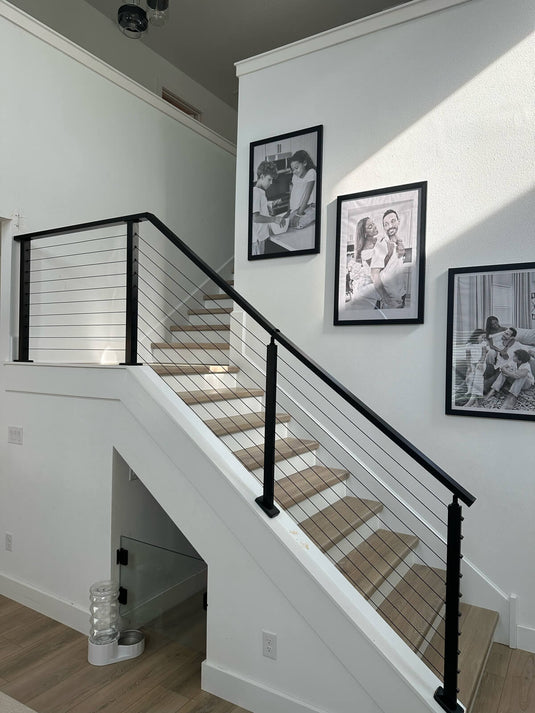TABLE OF CONTENTS
What Kind of Wood Should I Use for the Porch Railing?
Quick Answer: To choose the right wood for your porch railing, consider pine for affordability and adaptability, cedar for its natural beauty and rot resistance, redwood for its durability and unique hues, or pressure-treated lumber for a practical, budget-friendly option. Each type has its own balance of cost, durability, maintenance needs, and aesthetic appeal, so match the wood to your home's style, local climate, and maintenance willingness. For a modern touch, blending wood railings with cable can create a contemporary look.
A beautifully crafted wooden porch railing becomes a focal point, adding warmth and character to your home's curb appeal. With numerous wood types to select from, choosing durable, visually pleasing materials suited to your climate and architecture while balancing your budget can be challenging. Key factors around adaptability, longevity, style cohesion, and cost require consideration when deciding on pine, cedar, redwood, or premium woods. Ultimately, match railing wood to your exterior’s personality.

Key Considerations Before Choosing Wood for Your Porch Railing
Adapting to Your Climate
Analyze your local climate and how moisture, aridity, sun exposure, and temperature fluctuations impact different woods over time through expansion, contraction, rotting, or pests. Pressure-treated pine and cedar better withstand the swelling effects of high humidity. Meanwhile, pine sufficiently endures arid conditions and has fewer moisture concerns. Your region should guide wood selection.
Balancing Durability with Maintenance
Natural woods left untreated require frequent maintenance in harsh outdoor settings despite their visual appeal. Handsome woods like Ipe decay quickly without proper sealing/staining. Compare future maintenance commitments against wood grade/durability when evaluating cost trade-offs. Although pricier upfront, durable, resilient woods reduce long-term costs from frequent staining, replacing degraded rails, and labor fees over untreated woods requiring continual upkeep.
Aesthetic Cohesion with Architecture
Match your railing wood aesthetics to exterior architectural style for visual unity. For instance, rugged mountain homes clad in cedar shake siding complement textured cedar or redwood rails, while ornate Victorian trims pair attractively with smooth, detailed hardwoods like ash or oak. Consider existing design elements when selecting wood textures.
Budget
Porch railing wood costs vary extensively by type, from $3 per linear foot for basic pressure-treated pine upwards to $100 per linear foot for ultra-premium woods like grade-A teak. Since labor for installation remains consistent across wood types, Lifecycle expenses matter more than upfront material prices. Durable woods reducing future maintenance may justify initial pricing premiums through long-term savings. Budgeting 10-25% on railings is recommended.

Top Wood Choices for Porch Railings
Pine
As one of the most frequently used railing woods, pressure-treated pine is prized for its widespread availability, cost-effectiveness, and treatment, helping resist moisture, decay, and pests – which is crucial in exterior settings. Drawbacks include the potential for splintering/splitting and lower natural water resistance without occasional sealing. Overall, pine provides the best balance of practicality, functionality, and affordability.
Cedar
Western red cedar is treasured for its rustic visual charm, showcasing appealing wood grain textures and natural oils that help repel water and pests. However, its soft composition leads to potential scratches and dents over time with use. Cedar carries a higher upfront investment yet requires less future maintenance. This dynamic highlights cedar’s core strengths of weather resistance paired with aesthetic quality for rustic architecture.
Redwood
Sourced from forests under sustainable management, old-growth redwood is uniquely prized for its visual splendor, showcasing subtle grain patterns and rich reddish-pink undertones. In addition, redwood holds natural structural integrity from decay-resistance compounds in its cellular composition. Consequently, redwood can last over a century with minimal upkeep required. Despite its exceptional resilience and beauty, high costs and limited intricate railing design capabilities make redwood an occasional accent wood rather than a primary material.
Treated Lumber
For homeowners prioritizing affordability and practicality over aesthetics, pressure-treated lumber checks all the boxes. Preserved pine, fir, and cedar undergo processes that help strengthen natural moisture, decay, and pest resistance – which is crucial for exterior settings. The trade-off for its budget-friendly practicality is the lack of inherent visual flair without secondary upgrades like staining, which increases costs. Still, treated lumber’s longevity endures over decades, offering versatility across goals.
Innovative Wood Porch Railings
Complementary Fusion of Natural & Modern Materials
Warm, organic woods like pine, cedar, and redwood seamlessly fuse with the sleek modernity of metal cable railings for an eclectic blended aesthetic. Crisscrossing diagonal cable designs handsomely interplay with vertically aligned wood posts and rails, infusing a contemporary edge onto classic porch railing materials. This harmonious blend adds stylistic versatility, suiting both stately Victorian homes and more rustic contemporary exterior architectures.
Customized Design Interpretations
Pine's renowned adaptability pairs attractively with numerous metal cable finishes and color options ranging from brushed steel to antique copper. This enables tailored railing combinations customized to homeowner preferences across the design spectrum from ultra-contemporary to farmhouse classic. Pine’s neutral versatility also allows the beauty of stained cedar and redwood to shine when paired with black or stainless steel cable.
Beyond finishes, wood contributes natural visual cohesion through the textural grains unique to each species, like oak’s wavy patterns or cedar’s rugged knots. Meanwhile, the cable’s geometric transparency imparts multi-dimensional negative spaces outlined between crisscrossing slender tension lines. Strategically contrasting and balancing wood’s stability against the cable’s airy flexibility enables dynamic, unified designs catering to personal aesthetics.
Ideal Home Settings Suited to Blended Railings
Ideal settings for blended wood and cable porch railings include new construction homes with modern or transitional architecture motifs along with exterior facades featuring relaxed contemporary elements. For strictly traditional Victorian style ornamentation without existing contemporary features, plain wood railings better uphold desired decorative uniformity.
Meanwhile, recently built homes allow easy structural integration of metal cable post anchors during initial framing versus potential complex retrofitting onto older houses. New construction also pairs well with modern materials like cable, suited to clean lines and contemporary styling. Adaptive versatile pine and moisture-resistant cedar blend flawlessly with cable, adapting easily between rustic and sleek home profiles.
Climate & Durability Considerations
When incorporating exterior cable railings in any capacity, note that while wood selection should correspond to regional climate conditions, cable has its limitations regarding extreme cold and coastal humidity. Stainless steel cable proves more durable overall versus galvanized in resisting corrosion. Woods like pressure-treated pine and cedar are better equipped to endure humidity, moisture, sun exposure fluctuations, and potential insect damage regardless of cable pairing.
Implicit Longevity & Maintenance Requirements
Naturally, decay-resistant woods reduce repairs from degradation versus untreated alternatives. However, blended systems still require some periodic maintenance to uphold optimal integrity and aesthetics long-term. Budget-friendly pine disguises worn patinas better, needing refinishing every 2-3 years. Rich cedar tones integrate beautifully with cable, although they may need protective sealing every 1-2 years when exposed to harsh weathering. Discuss realistic upfront maintenance commitments with your contractor.
Creative Opportunities for Customization
Blending the modern sleekness of metal cable against natural wood's organic warmth allows for countless customized design interpretations. Mix and match complementary railing materials, finishes, patterns, and negative space alignments to your personality. For smaller budgets, creatively incorporate accent cable segments onto existing wood railings. Or make a statement through fully blended railing systems flanking an entryway. Thoughtfully fuse the old with the new for porch railings that endure beautifully.
Concluding Thoughts
Whether aiming for a touch of nature's elegance through cedar or redwood or a budget-friendly practical option with pressure-treated lumber, carefully select porch railing wood aligning with your exterior’s architectural style, regional climate conditions, and desired aesthetic and cost balance. Remember to account for long-term maintenance commitments against each wood’s natural durability. For innovative contemporary flair, blend classic wood's organic warmth alongside the sleek modern edge of steel cable accents. Thoughtfully designed wood porch railings ultimately enhance and complete your home’s exterior personality and welcoming allure for decades to come.




